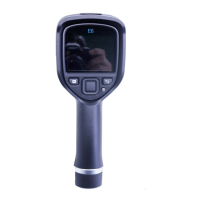Operation
8
8.16.2 Procedure
Follow this procedure:
1. Push the center of the navigation pad. This displays a toolbar.
2. On the toolbar, select Settings
. This displays a dialog box.
3. In the dialog box, select Measurement parameters. This displays a dialog box.
4. In the dialog box, select Emissivity. This displays a dialog box.
5. In the dialog box, select Custom material. This displays a list of materials with known
emissivities.
6. In the list, select the material.
8.17 Changing the emissivity as a custom value
8.17.1 General
For very precise measurements, you may need to set the emissivity, instead of selecting a
surface property or a custom material. You also need to understand how emissivity and re-
flectivity affect measurements, rather than just simply selecting a surface property.
Emissivity is a property that indicates how much radiation originates from an object as op-
posed to being reflected by it. A lower value indicates that a larger proportion is being re-
flected, while a high value indicates that a lower proportion is being reflected.
Polished stainless steel, for example, has an emissivity of 0.14, while a structured PVC
floor typically has an emissivity of 0.93.
For more information about emissivity, see section 16 Thermographic measurement tech-
niques, page 76.
8.17.2 Procedure
Follow this procedure:
1. Push the center of the navigation pad. This displays a toolbar.
2. On the toolbar, select Settings
. This displays a dialog box.
3. In the dialog box, select Measurement parameters. This displays a dialog box.
4. In the dialog box, select Emissivity. This displays a dialog box.
5. In the dialog box, select Custom value. This displays a dialog box where you can set a
custom value.
8.18 Changing the reflected apparent
temperature
8.18.1 General
This parameter is used to compensate for the radiation reflected by the object. If the emis-
sivity is low and the object temperature significantly different from that of the reflected tem-
perature, it will be important to set and compensate for the reflected apparent temperature
correctly.
For more information about reflected apparent temperature, see section 16 Thermo-
graphic measurement techniques, page 76.
#T559828; r. AK/40423/40448; en-US
26

